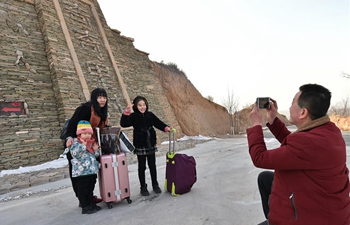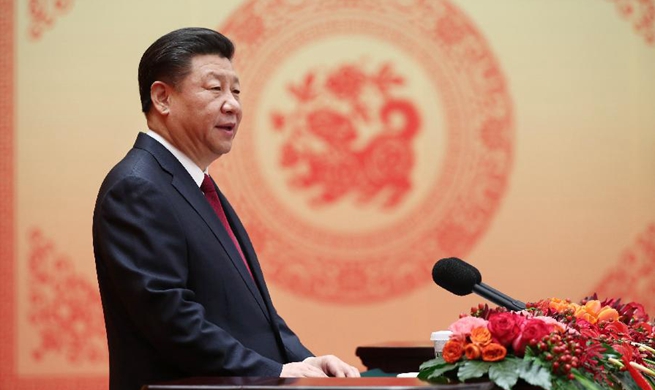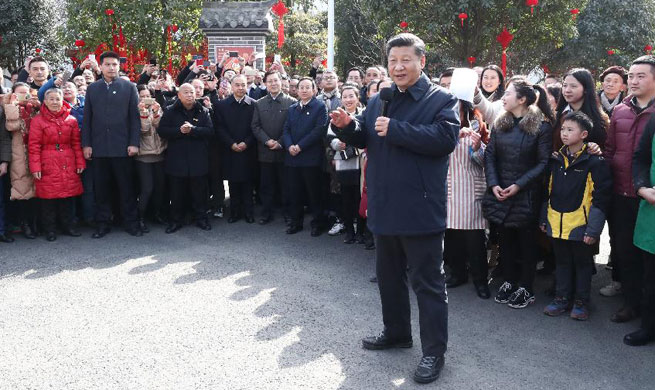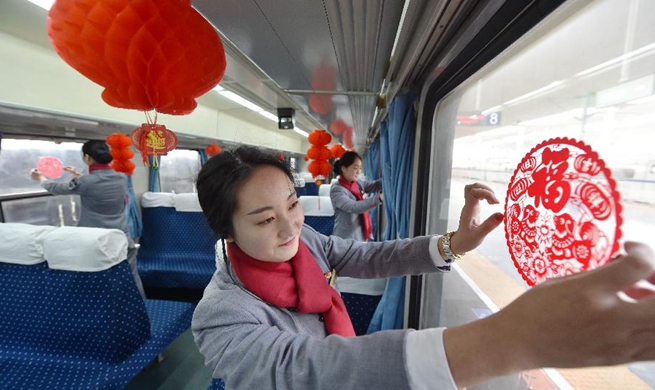HELSINKI, Feb. 14 (Xinhua) -- Wei Xuechao, a 31-year-old freelance photographer, made his third trip to Finland lately, and he had not expected to see so many shops and merchants in the Arctic city of Rovaniemi accepting Alipay, a digital payment solution favored by Chinese.
Whether a photo gallery, cafe, restaurant, wooden cabin, or even a Husky safari, it is very likely that you can buy services simply by scanning the barcode with your smart phone.
"When I approached the checkout counter at a souvenir shop, the cashier recognized from my appearance that I might be of East Asian origin, and asked if I would like to shop with Alipay," Wei said, adding he felt the same level of familiarity as if he was going to buy a jianbingguozi, or Chinese hamburger, at a street vendor back in Beijing.
MORE CHINESE TRAVELERS
As the Chinese Lunar New Year approaches, the so-called official hometown of Santa Claus in northern Finland has been witnessing a tourist surge.
Chinese tour operators expect 6.5 million overseas trips to be made during the upcoming Spring Festival, a rise by 7 percent from last year. An increasing number of the travelers choose to go to the Finnish Lapland area in the winter, since they usually experience warmer destinations in western and southern Europe in the summer.
Travel from China to Finland has grown tremendously during the past two years, said Paavo Virkkunen, head of Visit Finland, an organization funded by the Finnish government to promote Finland as a tour destination.
The year 2017 continued to witness growth of Chinese tourists. Chinese overnight stays were over 300,000, an increase by nearly 40 percent from the previous year, said Virkkunen, who believed the Year of the Dog, which starts on Feb. 16 this year, would be promising as well.
CHANGING TRAVEL STYLES
He told Xinhua that Chinese used to travel in large groups arranged by tour agencies, but the demand for individual tourism has grown rapidly in recent years -- a sign that the new generation of travelers is coming to the market.
"People who were born in the 80s or after have a good knowledge and the opportunity to travel to different places, and they also have good language skills so communication is no problem," Virkunnen elaborated.
Targeting the millennial group, Finnish merchants have been able to react quickly. "We want to make traveling and tourism for Chinese tourists as easy and convenient as possible. One example is the application of Alipay, which makes life easy for Chinese tourists in Finland," said Virkkunen. He said he is happy to see the payment method broadly accepted in Finland.
Last Spring Festival saw a remarkable action by Finnair, Finland's national carrier, to activate Alipay during its eight-hour flights from Helsinki to Shanghai and vice versa. It became the first airline to allow mobile payment system on board.
Since then, a majority of the in-flight sales have been made through Alipay, Finnair sources said.
The upcoming Spring Festival will see similar move by major Finnish taxi company Lehitaksi. The group maintains one of the biggest networks in Finland consisting of 1,250 cabs. However, it is not the first taxi operator to install Alipay onboard. Santa Line, based in Rovaniemi, adopted Alipay in late 2017.
VIABLE CASHLESS SOLUTION
Both big users of Alipay, Nana and her boyfriend Ji Changyuan were surprised to see the visibility of Alipay in the thousands of tourist operators and retail shops in Finland. The biggest local department store Stockmann joined the ranks in September 2017 as well, she was told.
"It is like in Tokyo, and in some areas even better than Tokyo," said the young couple, who were living in the Japanese capital as overseas students.
Comparing the usage of Alipay in Finland with that in Japan, they mentioned the "full coverage in the chain of scenarios" where a traveler can book flights, pay for accommodation, go shopping, dining, have a coffee, enjoy recreational activities, and call a taxi with a mobile application.
The young couple spent some 2,000 euros (2,482 U.S. dollars) in the six-day stay in Rovaniemi and Helsinki, and 95 percent of the expenditure was paid through Alipay. "We brought 600 euros cash just in case, but we have more than 500 left now," she told Xinhua when checking out at the Holiday Inn hotel in central Helsinki before going to the airport.
"I have never imagined a European country accepts Alipay so widely, and I would have brought much less cash if I had known in advance." Nana said she believes mobile payment ranks the first in respect of security, and will never use other payment methods whenever the mobile pay is accepted.
Operated by Ant Financial Services Group, a related company of Alibaba, Alipay is the world's leading mobile and online payment platform. It currently has over 520 million active users. The first payment choice in China is now accepted by merchants across 38 countries and regions.
"China has the most tested digital payment systems in the world, developed almost from scratch. Interestingly, Europe has the most developed bank card system, and is thus reluctant to accept even the more advanced solutions," said Alexander Yin, chief finance officer of ePassi, a major digital payment company in Finland.
The case study of Finland shows that digital payment will ultimately come to Europe, especially as more Chinese are spending large while traveling across borders, Yin added.

















